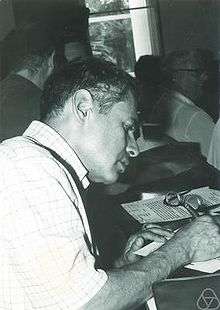Irving Segal
| Irving Segal | |
|---|---|
 Irving Segal in Nice, 1970 | |
| Born |
September 13, 1918 The Bronx, New York |
| Died |
December 24, 1998 (aged 80) Lexington, Massachusetts |
| Nationality | American |
| Alma mater | Yale University |
| Scientific career | |
| Fields | Mathematics, Cosmology |
| Institutions |
MIT University of Chicago |
| Doctoral advisor | Einar Hille |
| Doctoral students |
John C. Baez Robert J. Blattner Lester Dubins Henry Dye Abel Klein Bertram Kostant Ray Kunze Ernest Michael J. Edward Nelson Isadore Singer |
Irving Ezra Segal (September 13, 1918 – August 30, 1998) was an American mathematician known for work on theoretical quantum mechanics. He shares credit for what is often referred to as the Segal–Shale–Weil representation.[1][2][3][4]
Early in his career Segal became known for his developments in quantum field theory and in functional and harmonic analysis, in particular his innovation of the algebraic axioms known as C*-algebra.
Biography
Irving Ezra Segal was born in the Bronx in 1918 to Jewish parents.[5] He attended school in Trenton. In 1934 was admitted to Princeton University at the age of 16. He was elected to Phi Beta Kappa, completed his undergraduate studies in just three years time, graduated with highest honors with a Bachelors in 1937, and was awarded the George B. Covington Prize in Mathematics. He was then admitted to Yale, and in another three years time had completed his doctorate, receiving his PhD in 1940. Segal taught at Harvard University, then he joined the Institute for Advanced Study in Princeton on a Guggenheim Memorial Fellowship, working from 1941–43 with Albert Einstein and Von Neumann. During World War II Segal served in the U.S. Army conducting research in ballistics at the Aberdeen Proving Ground in Maryland. He joined the mathematics department at the University of Chicago in 1948 where he served until 1960. In 1960 he joined the mathematics department at M.I.T. where he remained as a professor until his death in 1998. He won three Guggenheim Fellowships, in 1947, 1951 and 1967, and received the Humboldt Award in 1981. He was an Invited Speaker of the ICM in 1966 in Moscow and in 1970 in Nice. He was elected to the National Academy of Sciences in 1973.
Segal died in Lexington, Massachusetts in 1998. Edward Nelson's obituary article about Segal concludes: "...It is rare for a mathematician to produce a life work that at the time can be fully and confidently evaluated by no one, but the full impact of the work of Irving Ezra Segal will become known only to future generations.[6]"
Selected publications
- Decompositions of operator algebras, I and II. Memoirs of the American Mathematical Society, no. 9. 1951.
- Mathematical problems of relativistic physics. Lectures in Applied Mathematics, vol. 2. American Mathematical Soc. 1963; with an appendix by George W. Mackey
- with Ray Kunze: Integrals and operators. McGraw-Hill. 1968. Revised & enlarged 2nd edition. Grundlehren der mathematische Wissenschaften, vol. 228. Springer-Verlag; pbk reprint of 1978 2nd edition
- Mathematical cosmology and extragalactic astronomy. Pure and Applied Mathematics Series, Vol. 68. Acadmeic Press. 1976. [7]
- with John C. Baez and Zhengfang Zhou: "Introduction to algebraic and constructive quantum field theory". Princeton University Press. 1992. [8] 2014 reprint.
- with Nicoll, J.F., Wu, P., Zhou, Z. 1993, Statistically Efficient Testing of the Hubble and Lundmark Laws on IRAS Galaxy Samples, ApJ. 465-484
- with Zhou, Z. Oct. 1995, Maxwell’s Equations in the Einstein Universe and Chronometric Cosmology, ApJS. Ser. 100, 307-324
- Cosmic time dilation, 1997, ApJ. 482:L115-17
See also
Notes
- ↑ Segal, I.E (1962), Lectures at the 1960 Boulder Summer Seminar
- ↑ Shale, D. (1962). "Linear symmetries of free boson fields". Trans. Amer. Math. Soc. 103: 149–167. doi:10.1090/s0002-9947-1962-0137504-6.
- ↑ Weil, A. (1964). "Sur certains groupes d'opérateurs unitaires". Acta Math. 111: 143–211. doi:10.1007/BF02391012.
- ↑ Kashiwara, M; Vergne, M. (1978). "On the Segal-Shale-Weil representation and harmonic polynomials". Inventiones Mathematicae. 44: 1–47. doi:10.1007/BF01389900.
- ↑ "Irving Ezra Segal - Biography". Retrieved May 20, 2013.
- ↑ Obituary in Americal Mathematical Society Notices
- ↑ Taub, A. H. (1977). "Review of Mathematical cosmology and extragalactic astronomy by Irving Ezra Segal". Bull. Amer. Math. Soc. 83: 705–711. doi:10.1090/S0002-9904-1977-14356-5.
- ↑ Kon, Mark A. (1993). "Review of Introduction to Algebraic and Constructive Quantum Field Theory by J. C. Baez, I. E. Segal, and Z. Zhou" (PDF). Physics Today. 46: 43. doi:10.1063/1.2809125.
References
- Segal, I.E (1962), Lectures at the 1960 Boulder Summer Seminar, AMS, Providence, RI
- Habermann, Katharina; Habermann, Lutz (2006), Introduction to Symplectic Dirac Operators, Springer-Verlag, ISBN 978-3-540-33420-0